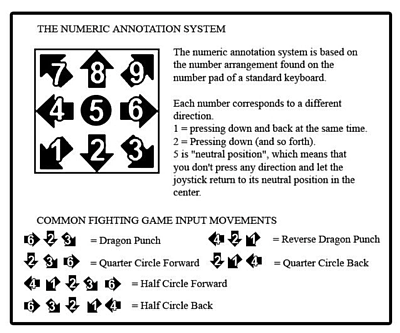There are 2 forms of common notation, traditional (six button) and numpad notation. Traditional notation refers to directions and motions by their English names. Numpad notation uses numbers and sequences of numbers to refer to directions and moves, as corresponds with a number pad.
Six Button Notation
- Jab - Light Punch (LP)
- Strong - Medium Punch (MP)
- Fierce - Hard Punch (HP)
- P - any punch
- PPP or 3P - all three punches simultaneously
- Short - Weak Kick (LK)
- Forward - Medium Kick (MK)
- Roundhouse (RH) - Hard Kick (HK)
- K = any kick
- KKK or 3K - all three kicks simultaneously
Motion Abbreviations
Most special move commands consist of one or more of the following motions combined with an appropriately timed button input, typically following the completion of the motion.
QCF - Quarter Circle Forward (D, DF, F)
QCB - Quarter Circle Back (D, DB, B)
HCF - Half Circle Forward (B, DB, D, DF, F)
HCB - Half Circle Back (F, DF, D, DB, B)
DP - Dragon Punch Motion (F, D, DF)
RDP - Reverse Dragon Punch Motion (B, D, DB)
360 - Full Circle Motion (for example F, D, B, U, F)
720 - Double Full Circle Motion (for example F, D, B, U, F, D, B, U, F)
AD - Air dash (in air, PP); Commonly followed by specified direction
(e.g. ADDF = Air dash DF)
PP or 2P - Press two punches simultaneously
(e.g. LP + MP)
PPP or 3P - Press all three punches simultaneously.
KK or 2K - Press two kicks simultaneously
(e.g. MK + HK)
KKK or 3K - Press all three kicks simultaneously.
Charge - Hold specified input for ~two seconds before proceeding to next command.
Example
Cammy combo in SFV: j.HP, cr.LP, b.MP > HK xx HK Cannon Spike xx CA
So in this example, Cammy jumps in with Hard Punch, does crouching Light Punch on landing, links that to back Medium Punch, which chains into Hard Kick target combo, which she cancels into Hard Kick Cannon Spike, then super cancels into Critical Art (SFV's Super Combo).
Numpad Notation
Often a numbering system is used to discuss joystick positions. Below is a guide explaining how this notation works.
.- up (u)
|
up+back (ub) - 7 8 9 - up+forward (uf)
back (b) - 4 6 - forward (f)
down+back (db) - 1 2 3 - down+foward (df)
|
`- down (d)
Note: These numbers can be easily referenced by looking at your keyboard "numpad". Think of it as a joystick/controller that is facing to the right. "5" is used to signify "neutral".
Motion Abbreviations
- 236 - Tilt stick downwards, then to downwards and forward, then forward.
- 214 - Tilt stick downwards, then to downwards and backward, then backward.
- 41236 - Tilt stick backwards, then to downwards and backward, then to downward, then to downwards and forward, then forward.
- 63214 - Tilt stick forwards, then to downwards and forward, then to downward, then to downwards and backward, then backward.
- 623 - "Dragon punch" or DP, Tilt stick forwards, then to downward, then to downward and forward.
- 360 - Full circle - Complete a full (360 degree) rotation of the stick
- 720 - Two full circles - Complete two full (720 degree) rotation of the stick
- Charge - [2]8 - [4]6 - Hold a tilt - Hold the stick in either B or D (Depending) then move to F or U respectively.
- [ ] - Indicates the button or direction inside the brackets is to be held down, such as for a charge move or the point where one begins holding a button to set up for negative edge.
- ] [ - Indicates the button or direction inside the brackets is to be released, such as for a negative edge move, like Boxer's Turn Around Punch, or Cody's Zonk Knuckle.
Common Nomenclature
State Modifiers
These prefixes refer to the position, or "state" you should be in when executing the respective attack.
s. - Standing; always followed by specified attack
(e.g. s.LP = Standing LP)
c. - Crouching; always followed by specified attack
(e.g. c.MP = Crouching MP)
j. - Jumping; always followed by specified attack
(e.g. j.HP = Jumping HP)
sj. - Superjumping; always followed by specified attack
(e.g. sj.LK = Superjumping LK)
cl. - Close; should be performed close to the opponent, while standing
(e.g. cl.Forward, perform a Forward while standing close to the opponent)
f. - Far; should be performed far from the opponent, while standing
(e.g. f.Forward, perform a Forward while standing far from the opponent)
+ - Simultaneously with; always placed between two actions
(e.g. F+MK = Press forward and MK)
xx - cancel; always placed between two actions
(e.g. c.MK xx QCF+P = Cancel c.MK into QCF+P)
-> - chain; always placed between two actions
(e.g. s.LP -> s.MP = Chain s.LP into s.MP)
/\ - jump; clarifies transition from ground to air actions
(e.g. c.HP /\ j.LP = Jump-cancel c.HP into j.LP)
\/ - land; clarifies transition from air to ground actions
(e.g. j.HP \/ s.LP = Follow j.HP with s.LP)
Connectors
- ~ Immediately after, e.g "Strong~Fierce" means press Fierce IMMEDIATELY after Strong, f~f means to double tap forward (dash).
- , Link
- xx Special Cancel
- > Chain Cancel
- jc Jump Cancel
- sj Super Jump Cancel
- adc Air Dash Cancel
Miscellaneous Notation
- Claw = American Vega = Japanese Balrog
- Boxer = American Balrog = Japanese Bison
- Dictator (Dic) = American Bison = Japanese Vega
Not everyone plays on the American version, and some character names are different in the Japanese version, so to avoid confusion, we should not use the names Vega, Bison, or Balrog.
